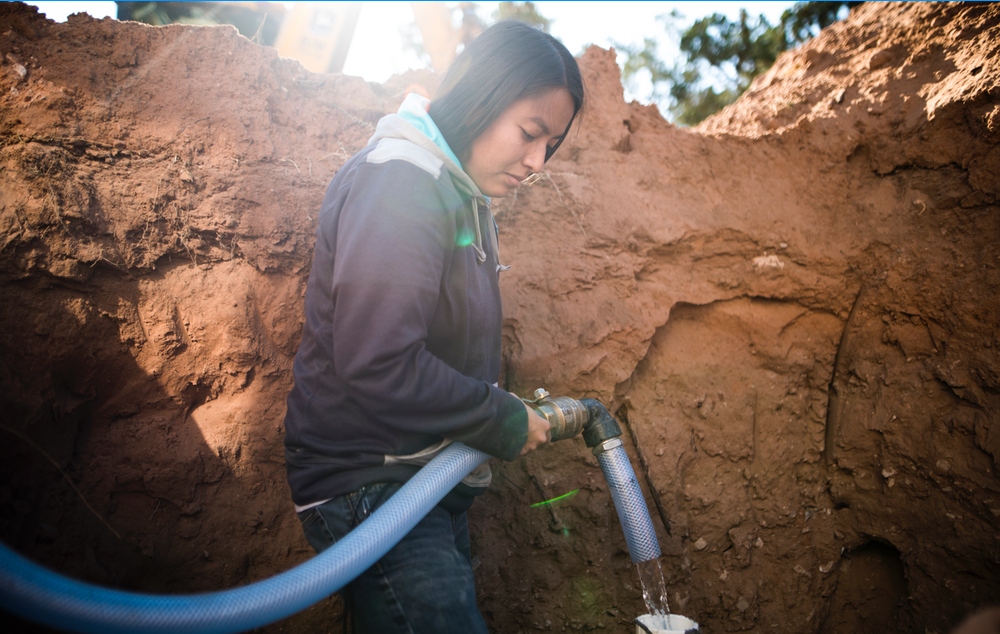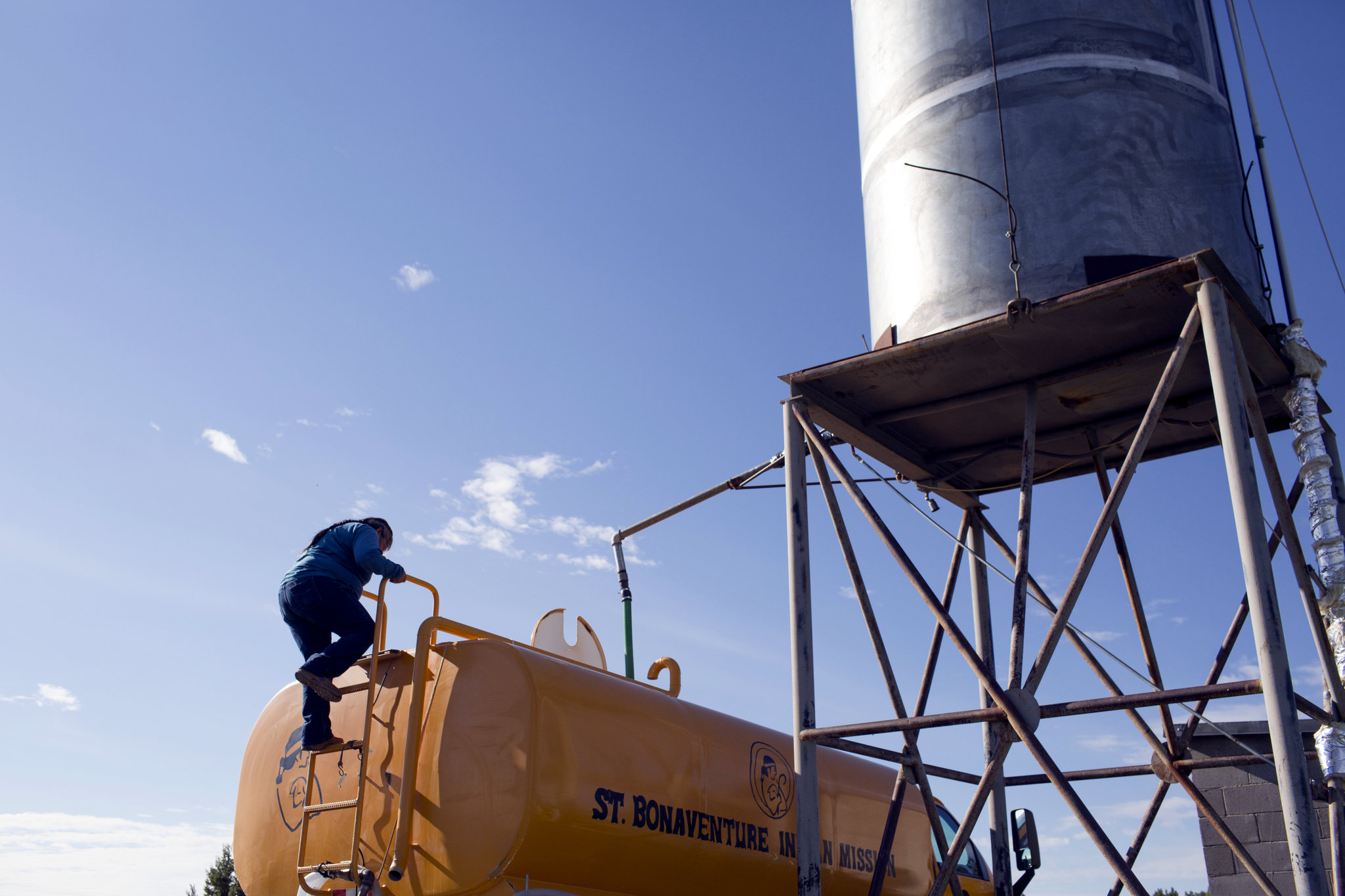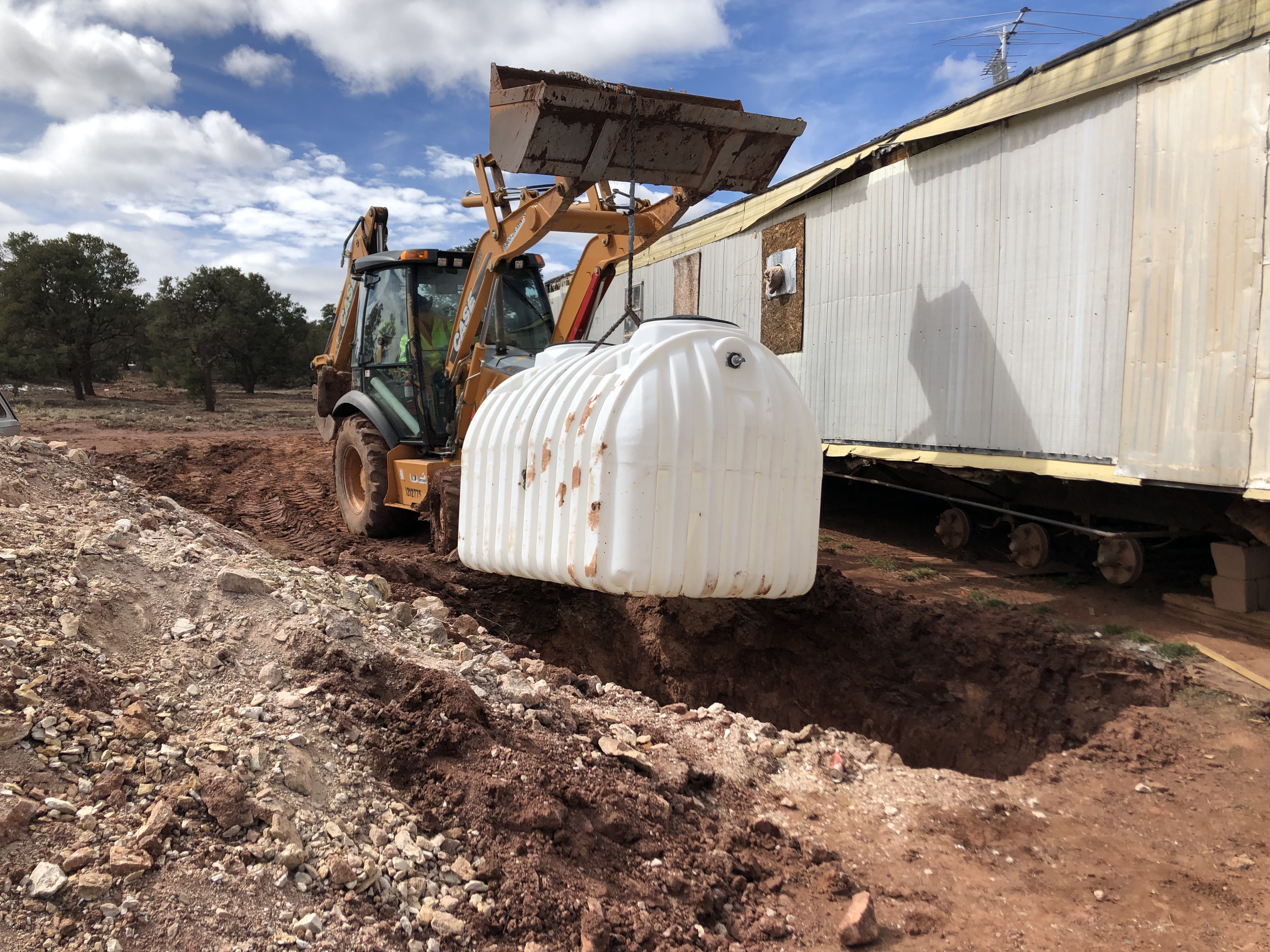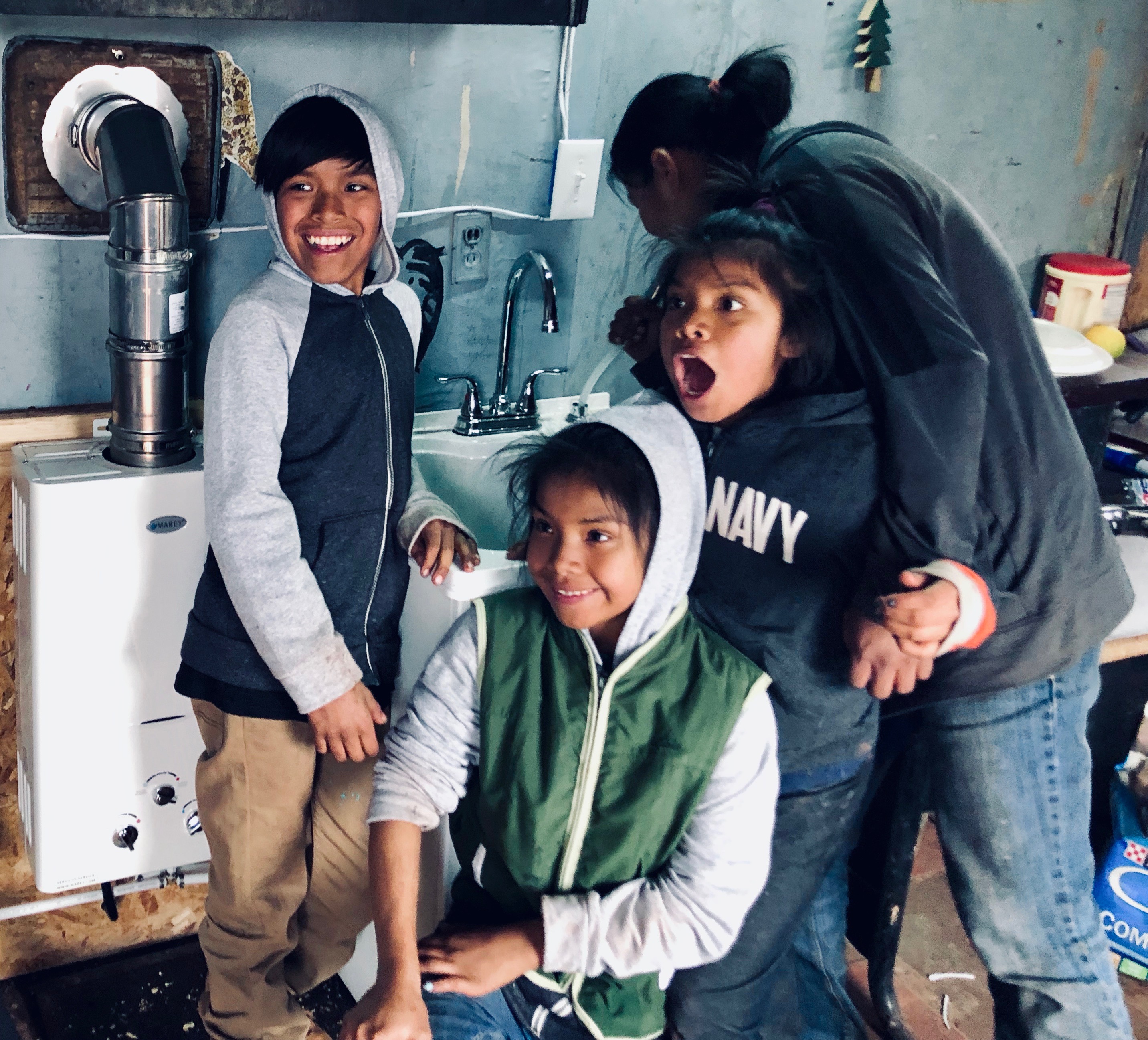Native American Heritage Month ends today, November 30th. That means many Indigenous issues are going to be forgotten by mainstream media, schools, and fair-weather advocates. That’s why we’re talking about it now. Come December 1st, the harrowing difficulties facing Indian Country aren’t going away, but the spotlight is.
With all that in mind, I reached out to Emma Robbins, a Diné artist and Executive Director of the Navajo Water Project. Robbins works tirelessly to help bring water to one of the nation’s more water-depleted communities, the Navajo Nation — where 30 percent of the population doesn’t have access to safe drinking water or sanitation. That lack of water has led to dire living conditions which, in turn, have contributed to Indigenous people dying at twice the rate as white Americans during the COVID-19 pandemic.
I know this and Robbins knows this because our families are living on Indian reservations, where these issues are inescapable. But these problems simply aren’t covered on a national stage very often. To help keep the conversation moving, I reached out to Robbins to chat about her work in Navajo Nation with getting water to people, the cultural impact of having running water, and how you can actually keep this stuff on your radar beyond 30 days in November.

Can you first tell us a little bit about your background and how you got into water conservation?
Definitely, so, I am Diné. I’m from the Navajo Nation. I am from the largest community, which is Tuba City, Arizona. My family — my cousins, grandparents, aunts and uncles — are from Cameron, Arizona, which is a small community about 30 miles away. There isn’t water infrastructure there like there is where I grew up, and that was a big thing in terms of getting into water conservation and rights, and making sure that people had clean running water because I grew up seeing the big differences of how my family lived versus how I lived during the week.
How so?
On the weekends, we — my sisters and me — would spend time at my grandparents’ house in Cameron. There’s a lot of uranium contamination in the water there, and that made a lot of my family members, specifically my grandmother, sick. She eventually passed from the uranium in the groundwater and air.
And … that was something that really affected me because I didn’t want to see anybody else get sick from that … and I think you can’t be Native and not care about water or the earth because it’s just so much a part of our culture and who we are.
Absolutely. Let’s talk about the Navajo Water Project. Can you walk us through how it was founded and its purpose?
I’m the executive director of the Navajo Water Project with DigDeep. DigDeep is an organization that works with 2.2 million Americans, getting them access to safe drinking water and both hot and cold running water in their homes.
The Navajo Water Project is the largest project to date. We work across the entire Navajo Nation, which is a sovereign nation that occupies three states — so Arizona, Utah, and New Mexico. We’re doing a variety of projects there, but the main point is that 30 percent of Diné living on the reservation don’t have access to clean running water in their homes.
That number always shocks me.
And as I mentioned, not only is there a lack of infrastructure and clean running water and sanitation because not having a bathroom is a huge issue, they’re also living very close to unsafe water sources. That means that those people might have to haul water from a too far away potable source.
So, we do a variety of projects. We install what are called hauled water systems in homes. These are off-grid systems that consist of an underground water tank that pumps the water into the houses. There’ll be one sink for this. This water comes from a route of delivery trucks that haul water from safe, potable sources. So, it’s really important that we find new water sources and help develop them across all three states.
We also worked with St. Michael’s Association for Special Education — a special needs school close to our capital of Window Rock. This is a school that has a very medically fragile population, and it’s something where they shouldn’t have to have this water and rely on bottled water. They had running water and the water was technically “safe,” but it wasn’t meeting secondary standards. That means the water was stinky, didn’t taste good, and was discolored. So, we helped replace their plumbing there, installed filters, and put new fixtures in and new water heaters powered by solar panels — all of which were the cause of the water issues that they were having.
Another facet of our work is helping people with bill pay, which is something we saw a rise in during COVID. In the beginning, when people weren’t able to work, they needed assistance paying simple bills. Then another element that came up due to COVID was in terms of water delivery. We stopped working inside of homes. So, that was a huge shift that we did during COVID. We delivered water to two 785 gallon storage tanks, which now were outside of the homes. We ended up installing about 1400 of those.
Wow.
At the beginning of the pandemic, we did emergency bottled water delivery while we sort of started figuring things out like how to make things more sustainable. What’s interesting is then that work took us into many new communities that we weren’t working in yet. That was really exciting for me because we got to work in Cameron again where my family’s from and where I’m technically from, and so that was a really big moment for me.
So now, what we’re doing is bringing families the 1200 gallon cisterns so that they can get running water from safe sources. We’re installing the entire systems that flow indoors, but it’s all outside, and there’s an outdoor spigot instead of an inside sink. Our plans are that when we move back into working inside of homes which will be in 2022, we’re going to take those spigots and convert them to indoor systems with a sink that has a water heater. Then, the next step is moving towards septic and sanitation so that people can get bathrooms as well.

What about maintenance because the Navajo Nation is in a very unforgiving climate? If somebody’s tank breaks down or their piping breaks down, what happens then?
That’s a super important question and something that we’re constantly thinking about when we’re doing planning ahead of time. I’ve seen this growing up on the reservation where people have really great intentions and there’s really great technology, but they’ll come in, install them, and then they leave. And that happens with a lot of things…
What we do is employ staff from the community and we are working in these communities for years. So we have people who call and say, “Hey, my system is freezing,” or “my pump stop working,” and so we’re able to send our people — who are amazing solar and water technicians — back to help families problem solve. Sometimes it requires a new part or sometimes it requires digging up the tank, there’s a variety of things.
When we do leave a community, which we still haven’t done yet, we want to make sure that we’re doing it correctly. So, we do train up community members who are working with our project partners on the ground. So, basically, there will be water and solar technicians there who will be doing what we were doing, but after we leave.
Where is the potable water actually coming from? What’s the process of getting that water onto trucks?
It’s a mix, depending on what part of the rez people are in. So in New Mexico, on the Eastern side of the reservation, we don’t just work in one small community, it’s basically a bunch of chapters.
Chapters?
Very briefly, our reservation is split up into what are called chapters. 110 chapters. Those are basically local government, but they’re also community centers, and oftentimes they’ll have a well, which has a watering point. But New Mexico, specifically, we get water from our project partner there, St. Bonaventure, who owns it, and so that’s on private land.
Whereas, in another chapter, we’ve developed a well working with the chapter’s local government. That’s something that we’ve identified and worked with engineers and consultants to make sure it’s safe when putting in that well.
Then in the other areas, we get water from the chapters’ watering points, or we’ll get water from the tribal utility authority, NTUA — Navajo Tribal Utility Authority — all of which are regulated and tested for safety.
And then during COVID, we did have to go off of the rez to areas like Winslow or Flagstaff to use their watering points because we didn’t want to have to travel very far with water because of fuel costs.
So looking at the importance of water, there is the very obvious importance in running waters necessary for sanitation, cooking, and everyday life, but how is water also important for the Navajo Nation in a cultural way?
I think there are probably two main parts that I can think of. You mentioned the cultural element. So, as you know, elders are the keeper of our language, our traditions, and our culture. So when we lose elders, we’re losing the libraries of that information, and our culture can potentially slowly die because those people are no longer around to teach us. So, one big thing is when an elder gets running water in their homes, they’re able to stay in their homes.
What we see is elders specifically need water to be healthy and to be safe. If they don’t have that, they might go to live with a family in a larger community or go to a nursing home where they’re no longer practicing the traditions or able to meet with people to share these things. And so, it’s important that we put running water into their homes so that they can stay and continue to do that.
Also when it comes to things like families who have sheep, or livestock, or who are growing their own food, and when they have to move to another community, they might not be able to maintain that lifestyle and their tradition. So, that is a really important element of making sure that people have water so that they can continue to live in their traditional ways.
Another element is mental help, right? If you constantly have to think about where your water is coming from or hauling that water, you’re putting in physical energy, money into gas, you need to have a truck, you need to make sure that you have tanks or clean receptacles to haul that water, you have to wait in line at different watering points. That’s a lot of mental stress. It’s something that’s on your mind constantly. Plus, you can only store so much water at a time. We’re in a desert and we’re at a high elevation. Those water receptacles could be exposed to the sun or there could be algae growth. So it’s something that you’re potentially thinking about 24/7.
And then related to that is if you’re going to school or work and you’re with other people who have had showers or who were able to take their medicine in the morning easily, or make a coffee, or feed their animals and give them water, it’s something that you feel very different … and there’s like this otherization there.
It’s really important that people get that water because I always think about this. Navajos, since the creation of the reservation, so for hundreds of years, we’ve had to be in this survival mode, and there hasn’t been an element of our lives where we all have been able to thrive. It’s constantly surviving and not thriving, and so if you have something like a basic need taken care of, you’re able to do things like spend that money somewhere else or rest, do arts, or participate in other events, or be with your family. So, those are two really important things to think about.

Absolutely! There are so many layers just to something as simple as water that most people take for granted. And part of that is the Navajo Nation is so vast and so rural, and in many cases disconnected from the outside world, what sort of long-term solutions are you looking at to make water more accessible while also keeping the character of the reservation and the culture intact?
The desert is a huge part of who we are and we don’t want to change everything, but I think what the future holds is making sure that people have that option. If they want to live near a water line, it shouldn’t be something that they have to wait years to be able to do. I mean, my grandparents waited decades to get running water in their home and it wasn’t until towards the end of my grandfather’s life that he was able to get that. He lived very traditionally. But it shouldn’t be something where people have to constantly fight for that option. I always think this is related back to treaties and broken treaties. I mean, every issue like this in Native nations can be traced back to a broken treaty.
So, I think the long-term is installing water lines so that people have running water throughout their entire home so that there’s no trucking involved, and so that people are able to just not worry about that. And I think that’s something that we’re still as the Navajo people are constantly thinking about. “How do we live in the 21st century and be modern?” Or, “How do we live and continue to be traditional?” Because a lot of people do equate not having water or electricity as continuing to live traditionally, but not everybody wants to live that way.
So, I think it’s about really pushing for infrastructure, working with the federal and tribal government to make sure that these things happen, and accountability — just making sure that we’re saying not only do these treaties need to be upheld for a trillion other reasons, but because we need things like water.
How can people support you and the Navajo Water Project and support people getting this water?
I think one of the main things is I always start out with learning more about the Diné because I think a lot of times, I used this word already, but there’s like this otherization and exotification like, “Oh, these poor Indians, they don’t have water.” You know?
Oh, for sure.
But there are a lot of movements going on apart from the Navajo Water Project and DigDeep. I mean, there are so many people who have been working on this problem and coming up with solutions forever. It’s not just like, “Oh, okay, we came in and nobody was doing anything before.” So, I think just learning about the Diné people and not continuing to practice this otherization, or just feeling sorry for people. So, I’d say learning a little bit about that and knowing why these problems exist in terms of helping us with the solutions, visiting our website, and following us on social media, and donating because, of course, that helps us with our projects.
I’d say that education is super important, and not only educating yourself but spreading that word to other people as well.
Right, and that’s what something like Giving Tuesday is about next week, it’s finding a chance to really dive into something like this.
Yeah, for sure, and it’s interesting because I think things like the Navajo Water Project because I think a lot of times people think, “Well, you can just give money and that’s the end of it.”
But we want to make sure that people are constantly thinking about this and remembering that there are so many people, who are probably nearby them with water issues. I mean, this isn’t an issue that only exists in one reservation far away. So thinking about ways to creatively educate people is always something good too past Giving Tuesday.
Yeah. And that leads to this month and how we started talking, in that it’s “Native American Heritage Month” right now. And we both see what happens after November: the posts stop coming up on social media, the news reports stop, the so-called coverage stops in schools. Our issues all go black and barely flicker in people’s again next November. What are some ways people can stay engaged the other eleven months that you have found to be very useful?
That’s a great question. I also run an Indigenous arts org. We’re called the Chapter House, based on our community centers of local government. And it’s something where I feel like we purposely don’t post stuff in November. Not because we’re, like, too good for it, but because our pitch in December is, “Hey, this is still continuing, let’s talk about that!”
I think one thing that people can do is Indigenizing their feed. Make sure you follow people who are posting about NDN Collective or the Chapter House or IllumiNatives or putting influencers, designers, or comedians on there. Then make sure that you follow them throughout the year. If it’s on your feed every day, you’re going to be reminded to continue to look at that. I mean, it seems silly, but who isn’t looking at their phone hours a day?
I know, right…
Also, follow what’s going on with our relatives, the Wet’suwet’en and Yintah Access Point for instance, and all of these movements that are in Canada. If you’re following one of those accounts I mentioned, they’re going to be constantly up to date with Indigenous events elsewhere.
I’d also say no matter where you are in the world, but, specifically, if you’re in this part of the so-called “Americas,” research whose land you’re on. Native-land.ca is a great tool for finding that out. Constantly looking at that when you move throughout any space is something to really think about. Once you learn who’s land you’re on, research the treaties that are in that area because these aren’t like relics of the past, they’re living documents.
And I’d say also just making a point to set aside some time to look at it because it is an actual huge issue for anyone who’s occupying this country. It’s something where you should constantly learn about it, not just in November.

You can support the Navajo Water Project here.
Dig Deep is also matching Giving Tuesday donations to the Navajo Water Project here.

